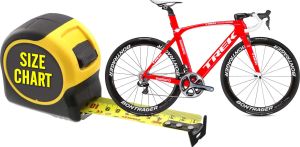My Road Bike Size Guide with Charts & Calculator
A comprehensive guide to road bike sizing & the perfect fit!
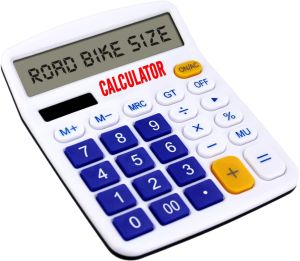
So you want to find the perfect road bike, but are unsure on sizing?
Here's my comprehensive guide to road bike sizing, including size charts and a calculator to establish the correct fitting road bike for your height, inside leg and upper body.
It also covers adjustments you can make to help your existing frame fit you better. Got a Question? Ask away!
What do you want to know about Road Bike sizing?
Select a topic below, or scroll down the page
▶ 1. Road Bike Size Calculator ▶ 2. Road Bike Size Charts ▶ 3. How to measure a road bike
▶ 4. Measuring your height ▶ 5. Measuring your inside leg ▶ 6. I'm inbetween Sizes? ▶ 7. Stand Over Height ▶ 8. Ideal Saddle Position? ▶ 9. Checking your Seatpost ▶ 10. Effective Top Tube Length ▶ 11. What is Reach? ▶ 12. Calculating Your Ape Index ▶ 13. Your Bike's Stack Height ▶ 14. To Conclude ▶ 15. Ask a Question
1.Road Bike Size Calculator
- Select your height and inside leg to find your correct road bike size
Men's Road Bike Size Calculator
1. Select your Height
or 2. Select your Inside Leg
Ladies Road Bike Size Calculator
1. Select your Height
or 2. Select your Inside Leg
2.Road Bike Size Chart
- Check your height and inside leg in the chart below to find your correct road bike size
Men's Road Bike Size Chart
Find your height in feet & inches (or cm) to check which men's road bike will fit you.
| Height (feet / inches) | Height (metres) | Inside Leg (inches) | Inside Leg (cm) | Frame Size (cm) |
| 4'10" - 5'0" | 1.48m - 1.52m | 26" - 27" | 66cm to 68cm | XX-Small(47cm - 48cm) |
| 5'0" - 5'3" | 1.52m - 1.60m | 27" | 69cm to 70cm | X-Small(49cm - 50cm) |
| 5'3" - 5'6" | 1.60m - 1.68m | 28" - 29" | 71cm to 75cm | Small(51cm - 53cm) |
| 5'6" - 5'9" | 1.68m - 1.75m | 30" | 76cm to 78cm | Medium(54cm - 55cm) |
| 5'9" - 6'0" | 1.75m - 1.83m | 31" | 79cm to 80cm | Large(56cm - 58cm) |
| 6'0" - 6'3" | 1.83m - 1.91m | 32" - 33" | 81cm to 85cm | X-Large(58cm - 60cm) |
| 6'3" - 6'6" | 1.91m - 1.98m | 34" - 35" | 86cm to 91cm | XX-Large(61cm - 63cm) |
Ladies Road Bike Size Chart
Find your height in feet & inches (or cm) to check which ladies road bike will fit you.
| Height (feet / inches) | Height (metres) | Inside Leg (inches) | Inside Leg (cm) | Frame Size (cm) |
| 4'10" - 5'1" | 1.48m - 1.55m | 26" - 27" | 66cm to 68cm | XX-Small(44cm - 46cm) |
| 5'1" - 5'3" | 1.55m - 1.60m | 27" | 69cm to 70cm | X-Small(47cm - 49cm) |
| 5'3" - 5'5" | 1.60m - 1.65m | 28" - 29" | 71cm to 75cm | Small(50cm - 52cm) |
| 5'5" - 5'8" | 1.65m - 1.72m | 30" | 76cm to 78cm | Medium(53cm - 55cm) |
| 5'8" - 5'10" | 1.72m - 1.80m | 31" | 79cm to 80cm | Large(56cm - 57cm) |
| 5'10" - 6'0" | 1.80m - 1.83m | 32" - 33" | 81cm to 85cm | X-Large(58cm - 60cm) |
| 6'0" - 6'6" | 1.83m - 1.98m | 34" - 35" | 86cm to 91cm | XX-Large(61cm - 63cm) |
3.How Road Bikes are measured
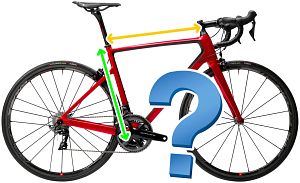
When buying a road bike, you need to ensure that it fits you properly.
An adult road bike's size is determined by the dimensions of the frame, with larger frames suiting taller riders.
The most important dimensions of a road frame are the frame size, followed by the effective top tube.
So how do you measure a bike frame?
- This frame size corresponds to the measurement from the centre of the bottom bracket (or chainring) upwards to the top of the seat tube (where the seatpost is inserted).
- The effective top tube is the horizontal line between the centre of the seat tube (where the seatpost is inserted) and the centre of the headtube (where the fork steerer exits the frame by the stem).
- Road Bikes sizes will be specified in either a S/M/L/XL system, or in centimetres.
- Compact road bikes are usually listed using the S/M/L/XL method, or with a virtual seat tube measurement in centimetres, based upon the sizing of traditional road frames (with a non sloping crossbar).
As with most products, sizing can differ between manufacturers, so it's worth checking their sizing and geometry table before commiting to a purchase.
▲ Return to top4.How do I correctly measure my height?
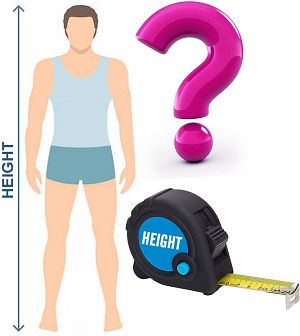
Most people have a rough idea of how tall they are, but how do you accurately measure your height?
You may need a helping hand, as well as a pencil and tape measure.
- Firstly, remove your shoes and stand upright ideally on a flat, hard surface with your back against a wall.
- Ensure your legs are together and you are standing straight.
- With the pencil held horizontally (parallel with the floor), get a friend to make a small pencil mark level with the top of your head.
- Next measure down from the pencil mark to the floor (not to the skirting boards!) and make a note of this reading in either cm or feet and inches.
A few tips below..
- If your friend is shorter than you, then they may wish to stand on a chair to ensure that the pencil mark is an accurate reflection of your height.
- If no-one is available to help you, then you can try and make this measurement yourself, although it may be a little less accurate.
- If you have a set square in your tool box, this can help to ensure that the pencil mark is level with the top of your head.
Now use this measurement on my road bike size calculator above.
▲ Return to top5.And what about my inside leg (inseam) measurement?
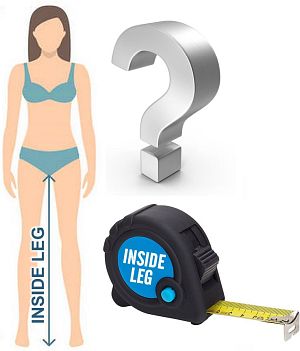
As per measuring your height (above), this is easier with an assistant.
- Take your shoes off and stand upright with your back against a wall, standing straight with your legs together.
- Next you can either slide a book, ruler or other straight object up against your crotch (pushing up any baggy clothing), or make a pencil mark.
- Next measure from this mark down to the floor to establish your inside leg measurement.
Again, record this measurement to avoid mistakes.
Once you're fully grown, these measurements shouldn't alter too much.
However, for teenagers and young adults you should measure these heights & lengths each time you buy a new bike.
Now take these two measurements and use them on my road bike size calculator (above) to establish the correct size road bike for your height.
▲ Return to top6.I'm inbetween two sizes - which should I get?
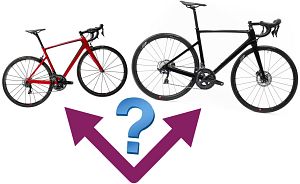
Generally speaking you should look at buying the smaller of the two sizes; you can always..
- Raise the saddle
- Push the saddle back slightly
- Or buy a longer stem to obtain a comfortable position.
- Riding a frame which is too large for you can be at best uncomfortable, and at worst potentially dangerous if you can't easily put your foot down.
7.Stand over Height
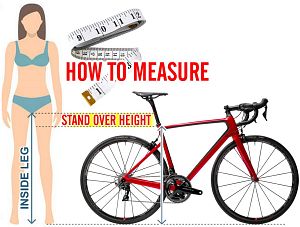
Essentially it's the gap between the crossbar and your crotch when you are "standing over" the bicycle's crossbar (not sitting on the saddle).
Stand over height is calculated by:
- Measuring from the top of the top tube (crossbar) of the bicycle near the saddle down to the ground.
- Subtract that from your inside leg measurement
i.e. 100cm (inside leg) - 90cm (crossbar height) = 10cm (stand over height).
Stand over Height Calculator
Enter your measurements below to calculate your Stand over Height
- You will need to ensure that this distance is a positive number (i.e. your inside leg is greater than the cross bar height), otherwise your crotch will be painfully coming into contact with the crossbar when dismounting.
- Typically this distance between the top tube and your crotch should be at least 1 inch when standing flat footed on the bicycle as otherwise you will encounter problems when mounting and dismounting the bike.
- On a road bike you do not need as much clearance as you would on a mountain bike; the terrain will be smoother and you won't need to manoeuvre both your body and the bike underneath you to the same degree.
Ensure you're wearing your cycling shoes or even barefoot when testing a bike's stand over height, as your regular shoes' height may give you an inaccurate result.
▲ Return to top8.Saddle Position
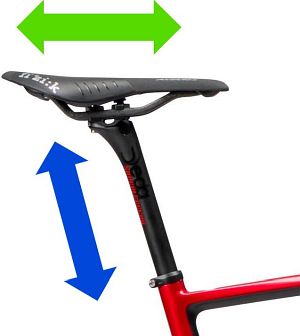
Getting the correct saddle height is vital when riding, and so it's important to ensure that your new bike will enable you to position your seat at the right height for you.
When Standing
Wearing your cycling shoes, whilst seated on the saddle with the bike upright.
- You should ideally be able to touch the floor on tip-toes.
- If this isn't possible, then your saddle is probably too high.
- If you can easily put a flat foot on the floor then you'll need to raise the saddle.
When Pedalling
- When pedalling, your leg should be slightly bent when at the bottom of the pedal stroke.
- If your leg is straight and your hips rock from side to side when pedalling, then the saddle is too high.
- Similarly, if your leg isn't bending that much then you're losing out on pedalling power, and you'll need to raise the saddle to unleash your potential!
The saddle should be mainly flat, and not sloping forwards or backwards excessively.
Everyone's preferences differs, but a horizontal saddle will keep you from sliding when pedalling, as well as helping to reduce rubbing or bruising on longer rides.
In terms of horizontal positioning, you will need to adjust the saddle until you find the position that works for you, both in terms of reach to the handlebars and pedalling comfort.
When sat on the bike
Level your pedals so the cranks are horizontal (in the 3 and 9 o'clock positions) with your front foot on the pedal.
- On your front leg, your knee cap should be directly above the ball of your foot (which in turn should be in line with the pedal axle).
- If your kneecap is in front of your foot, try adjusting the saddle back.
- If your foot is ahead of your kneecap, then your saddle will need to be moved forward.
With trial and error you'll find the sweet spot, and assuming that you use the same footwear and pedals then you won't have to adjust this again.
▲ Return to top9.Check your seatpost
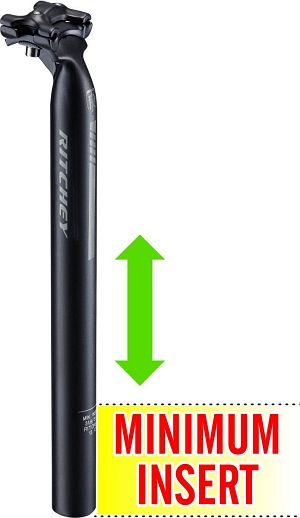
Traditional bike frames have a higher crossbar, whereas modern compact frames are typically smaller, and will have more seatpost showing.
It's important to pay attention to the seatpost, and in particular the "minimum insert" level.
- This refers to the minimum length of seatpost which needs to be inserted into the frame.
- Ignoring this can result in the frame and seatpost snapping due to excessive leverage.
If you require the seatpost to be higher than the minimum insert level allows, then the chances are you need a larger road bike frame.
Equally, if the seatpost is set at the very lowest position just above the crossbar then you might need a smaller frame (unless you are a young adult who is planning on "growing into" the bike).
▲ Return to top10.Effective Top Tube
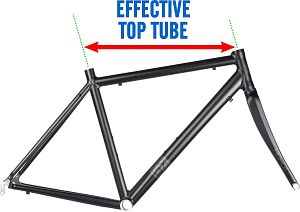
The most important dimensions of a road frame are the frame size as covered above, followed by the effective top tube.
The effective top tube is the horizontal line between the centre of the seat tube (where the seatpost is inserted) and the centre of the headtube (where the fork steerer exits the frame by the stem)
- The larger the frame, the longer the effective top tube, as it stands to reason that taller people will typically have a longer upper body and will need a more stretched out position when riding.
- Whereas smaller frames will have a shorter effective top tube, as shorter people tend to have smaller upper bodies.
11.What is Reach, and how to measure it?
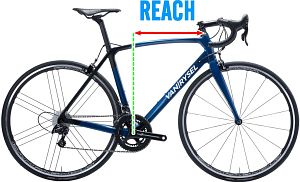
This brings us nicely onto the reach of a bicycle.
Similar to the effective top tube length, the reach of a bicycle refers to the distance between the vertical centre of the bottom bracket and the vertical centre of the head tube.
Gaining the optimal position on a road bike requires finding the correct reach for your torso and arm length.
This will ensure a comfortable ride, but also aid in riding efficiency in terms of pedalling, breathing and aerodynamics.
How to find your correct reach measurement?
You may need a friend to help hold the bike steady during this.
- Sit on the bike, with the saddle at the correct height, in a comfortable riding position
- Place both of your hands on the top of the handlebars, and then look down at the bars
- You shouldn't be able to see the axle of the front wheel
- If the axle appears in front of the bars then the reach is too short for your upper body.
- Similarly, if the axle appears beneath the bars then the reach is too long.
Minor adjustments to your "effective" reach can be made by moving the saddle forwards or backwards, or by fitting a different length stem.
How important is reach?
Given that this measurement can effectively be modified by adjusting two components, reach is slightly less vital than frame size when choosing a new bike:
- You can always fit a different sized stem
- Raise the bar height
- Or adjust your saddle position.
However it is still a factor worth considering, as you don't want to be stuck with either an extremely short or comically long stem which will alter the bike's handling.
- A short stem will result in twitchy and nervous steering.
- Whereas a longer model will make the bike's handling feel slow.
It's better to get a frame with approximately the correct reach rather than take a risk and get it wrong.
▲ Return to top12.So what's the Ape Index?
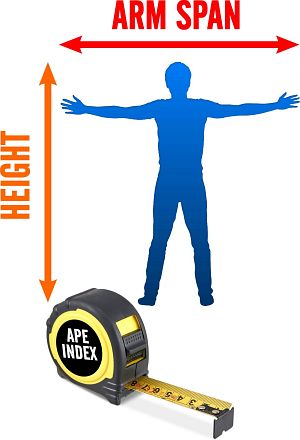
The Ape Index is essentially a comparison of your wing span (outstretched arm length) to your height.
It's usually calculated for sports where additional reach is an advantage, such as boxing or rock climbing.
However, it's also handy for establishing whether a bike's reach will be the correct size, when you've initially selected a bike using your overall height.
The average human has an ape index of 0 (when using the subtraction method). This means that their height minus their arm span equals zero (i.e. they have roughly the same value).
To calculate your ape index, we need to do the following:
- Measure your arm span in centimetres.
- Measure your height using the method we mentioned a few paragraphs above, again in centimetres.
- Height - Arm Span = Ape Index
or use my Ape Index Calculator!
Enter your measurements below to calculate your Ape Index
+5cm = Shorter Arms = Smaller Frame?
- If your Ape Index is 5cm or greater (i.e. your height is at least 5cm larger than your arm span) then you might want to consider a smaller frame size.
- The extra reach of a larger frame may be too long for your shorter upper body.
-5cm = Longer Arms = Larger Frame?
- If your Ape Index is -5cm or less (i.e. your arm span is at least 5cm longer than your height) then you might want to consider a larger frame size.
- The current reach of the smaller frame may be too short for your longer upper body.
Alternatively you can select your original choice of frame, and make minor adjustments with saddle height, position and stem length.
▲ Return to top13.What is Stack Height, and how does this affect me?
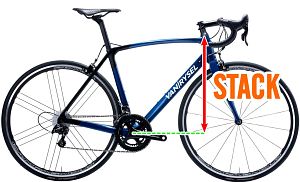
Stack height is the vertical measurement between the centre of the bottom bracket and the top of the upper headset cup.
In layman's terms, a vertical line from the bottom bracket axle up to where the upper fork steerer exits the frame (by the headset spacers or stem).
Stack height depends on two main criteria; the size of the frame and the type of road bike you have.
The larger the frame, the larger the stack height.
Similarly, the more relaxed the bike (such as a tourer or sportive road bike, with a more upright and comfortable position), the larger the stack height.
- For racing bikes and time trail models, the stack height is lower for more aggressive riding and aerodynamics.
- If a bike has a lower stack height, then it will have a longer reach, as you'll need to reach downwards further to hold the handlebars.
- Alternatively, if a bike has a bigger stack height then you won't need to reach as far, as the bars will be situated higher and thus closer to the saddle.
14.To Conclude!

Using my Size Calculator and Size Charts will give you a very good idea of the correct size bike for you.
If you gather your various measurements (Height, Inside Leg, Arm Span & Ape Index) and make a decision based upon these, then you won't go far wrong.
However given the cost of a road bike, it's worth double checking the manufacturer's sizing guide to confirm how their ranges size up.
If you're still unsure about sizing, then it's worth:
- Asking the shop for their advice
- Seeing if you can arrange a test ride
- Comparing the new bike's sizing & geometry to your existing one
You may also wish to invest in a professional bike fitting service - although this costs a reasonable sum of money, it is a fraction of the amount that will be spent on a new bike.
Remember: The more research you do, the more likely you are to get a bike that fits.
Hopefully you'll manage to get the perfect sized bike for many happy miles!
▲ Return to top
